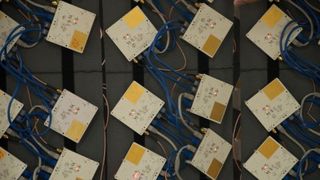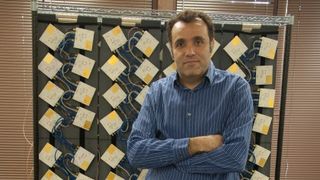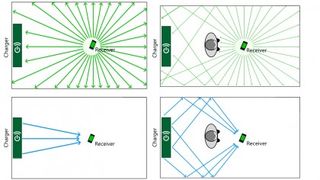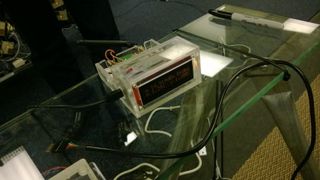Wireless power: could Cota make it long-distance and mainstream?
Is power over Wi-Fi the future of cord-free tech?

Replacing your phone's charging cable with a wireless charging pad you put it down on is delightful and convenient, but it's not enough of a difference that everyone will want to pay extra for it.
But charging your phone without ever having to take it out of your pocket? Now that would be convenient – and startup Ossia is working on a system to charge devices up to 30 feet away.
The Cota system, currently a large prototype (the final box will be much smaller) sends energy over a channel in the familiar 802.11b Wi-Fi spectrum that's only used in Japan, so it doesn't interfere with wireless data – and it doesn't need a special licence. It can even use the same antenna that's in your phone or tablet or even your Bluetooth headset already, just with some extra wiring.

The way it works is by putting a small beacon in the device you want to charge, which sends out a low-power signal. "It's about one millionth of the power of a Wi-Fi signal," Ossia CEO and Founder Hatem Zeine told TechRadar. The signal will be blocked by any people in the room, but it will also bounce off the walls and ceilings to reach the charger. The phased array of antennae in the charger (200 in the current prototype, 20,000 in the units that will ship in 2015) recreate the signal in reverse, sending power directly to the device and nowhere else.

If you move around the room, or you move your device, Cota will find it again and use the new signal path to send power. When I stood in the way of the prototype array it took a couple of seconds to find a path around me (in a large office room ten feet away from the wall); the final version will check 100 times a second and should reconnect without you noticing.

Cota sends out 1W of power; that's about as much as your phone uses, so it's more like trickle charging than plugging into the mains. If multiple devices are sending beacon signals, the system checks which has the lowest battery and charges that one first. "When everyone is out, it can charge your remote controls and smoke detectors," suggests Zeine, "then when you get home it starts charging your phone." And just like Wi-Fi, you can run it open so anyone can charge devices, or closed, so you aren't paying for your neighbour's phone.
The competition
The wireless charging that's already built into phones such as the Nokia 920 using the Qi standard is induction charging – a more sophisticated version of the way you charge an electric toothbrush. Power is transmitted from one coiled antenna to another and they have to line up and be close together. You can send power through a thin sheet of wood, but not across the room. New Zealand-based PowerbyProxi has recently joined the Wireless Power Consortium that creates the Qi standard, to incorporate its adaptive distance charging into Qi 2.0.
Get daily insight, inspiration and deals in your inbox
Get the hottest deals available in your inbox plus news, reviews, opinion, analysis and more from the TechRadar team.
When you put a device down on a pad using PowerbyProxi charging that should beat the 70% efficiency Qi claims to achieve, but it will also let you charge things a few inches away from the charger, and even upside down – as with Cota, they don't need to be in direct contact.
The magnetic resonance charging Qualcomm is using to charge electric cars is more efficient than inductive coupling, but the coils need to be much larger; although a large coil can send power six feet, a coil that fits in your phone could only be a foot away from the charger.

The only technology that claims to match Cota's 30 feet is charging by laser; that could go up to 300 feet but there are still potential safety issues and your phone has to be in direct line of sight. Ultrasound charging could reach up to ten feet and could deliver 40W (enough to charge a laptop) but you need a separate charger for every device and Hatem doesn't believe it's as efficient as Cota, which can send its 1W up to 30 feet in all directions and cover all the rooms in a two-storey house (at least in US buildings where brick walls are rare).
Mary (Twitter, Google+, website) started her career at Future Publishing, saw the AOL meltdown first hand the first time around when she ran the AOL UK computing channel, and she's been a freelance tech writer for over a decade. She's used every version of Windows and Office released, and every smartphone too, but she's still looking for the perfect tablet. Yes, she really does have USB earrings.
